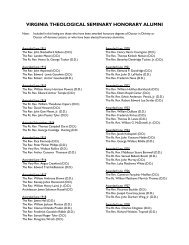Seminary Journal 2008 (August) - Virginia Theological Seminary
Seminary Journal 2008 (August) - Virginia Theological Seminary
Seminary Journal 2008 (August) - Virginia Theological Seminary
Create successful ePaper yourself
Turn your PDF publications into a flip-book with our unique Google optimized e-Paper software.
else of water and to empty rivers and<br />
underground water reserves in the<br />
process.<br />
The water “footprint” of Western<br />
countries on the rest of the world deserves<br />
to become a serious issue.<br />
Take cotton. Cotton grows best in hot<br />
lands with virtually year-round sun.<br />
Deserts, in other words. But it needs<br />
huge volumes of water. It empties<br />
rivers across the south. Old British<br />
colonies like Egypt, Sudan, and<br />
Pakistan still empty the Nile and the<br />
Indus for cotton growing in deserts,<br />
as they did when Britain ruled and<br />
Lancashire cotton mills had to be<br />
fed. In order to grow cotton, Pakistan<br />
consumes almost a third of the fl ow of<br />
the River Indus and enough to prevent<br />
any water reaching the Arabian Sea.<br />
Australia does much the same on the<br />
River Murray, which is drying up as a<br />
result. Anybody who has seen recent<br />
headlines from there will know they<br />
are in deep trouble.<br />
When Russia transformed the deserts<br />
of Central Asia into a vast cotton<br />
plantation, it began the destruction<br />
of the Aral Sea by tapping the rivers,<br />
like the ancient Oxus, that kept it full.<br />
The Soviet Union has since collapsed<br />
but cotton production continues.<br />
Uzbekistan is the second biggest cotton<br />
exporter in the world. Almost any<br />
cotton clothing you buy currently may<br />
contain cotton that helps dry up the<br />
Aral Sea—though I have been unable<br />
to fi nd any retailer or manufacturer<br />
who will admit to this.<br />
Other water-guzzling crops, such as<br />
rice and sugar cane and fodder crops,<br />
have similar impacts. Two-thirds of all<br />
the water taken from nature round the<br />
world goes to agriculture. So whenever<br />
you eat Thai rice or burgers made of<br />
meat from Central America, or clothes<br />
made from Pakistani or Uzbek cotton,<br />
you are infl uencing the hydrology of<br />
those countries—taking a share of the<br />
River Indus, the Mekong or the Aral<br />
Sea—or the Costa Rican rains.<br />
How have we come to this? Well,<br />
though our planet is still largely covered<br />
in water, we are coming up against<br />
practical limits. Here are some more<br />
numbers to illustrate this.<br />
Earth is the water planet. But more than<br />
97 percent of it is sea water that we<br />
cannot drink and cannot, except in very<br />
local circumstances, afford to purify. Of<br />
the remaining fresh water, two-thirds is<br />
locked up in ice caps and glaciers and<br />
one-third is in liquid form. But the great<br />
majority of this is in the pores of rocks,<br />
often deep and unavailable or contaminated<br />
with salt or arsenic or fl uoride,<br />
and the great majority of it is not being<br />
replaced by the rains. When we take it,<br />
we are often mining it.<br />
Our prime source of renewable water<br />
is at the Earth’s surface—moving water<br />
that nature constantly replenishes by<br />
evaporating it from the oceans and<br />
returning it to the Earth in clean rain.<br />
The natural water cycle is still recycling<br />
the water in which the dinosaurs bathed<br />
and the fi rst fi sh swam. It is the basis<br />
of life on Earth, and of our civilisations.<br />
So how much water runs through this<br />
cycle? And how much is available to us?<br />
The answer is that in a year, about<br />
120,000 cubic miles of water gets<br />
recycled. Because most of it falls as<br />
rain onto the ocean, this is not of much<br />
practical use to us. But for the rest, we<br />
are beginning to home in on the bit of<br />
the water cycle where we currently get<br />
most of our water.<br />
60 VIRGINIA SEMINARY JOURNAL AUGUST 2007



